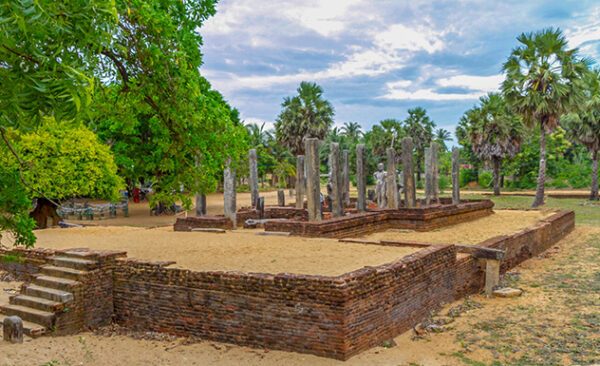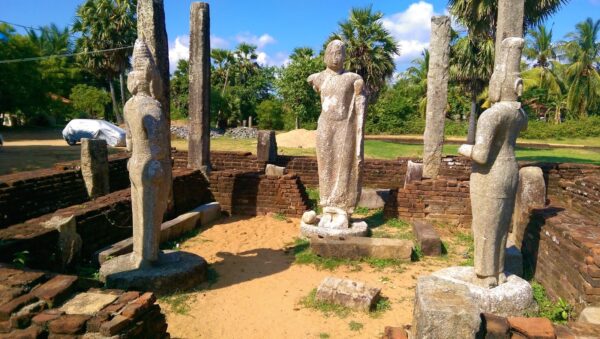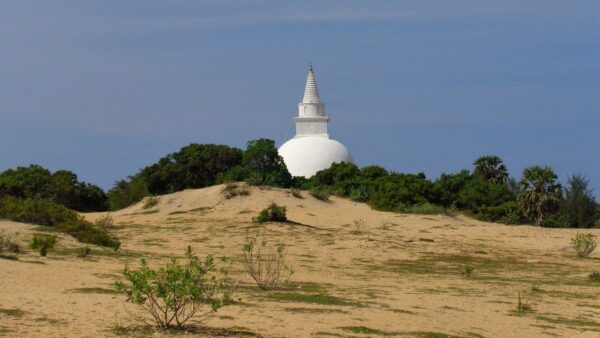Muhudu Maha Viharaya – steeped in history and legend
By Arundathie Abeysinghe

 Muhudu Maha Viharaya or the ‘Temple by the Sea’ is steeped in history and legend. Situated in *Pottuvil in *Ampara District, King Kawantissa (205-161 BC) who ruled the Kingdom of *Ruhuna had constructed this temple. The Temple is also an archaeologically significant heritage monument. There is a statue of the Buddha and two dolomite marble statues believed to be those of royalty facing the Buddha Statue in the temple premises. According to some scholars, the two statues facing the Buddha Statue are two attending *Bodhisattva Statues.
Muhudu Maha Viharaya or the ‘Temple by the Sea’ is steeped in history and legend. Situated in *Pottuvil in *Ampara District, King Kawantissa (205-161 BC) who ruled the Kingdom of *Ruhuna had constructed this temple. The Temple is also an archaeologically significant heritage monument. There is a statue of the Buddha and two dolomite marble statues believed to be those of royalty facing the Buddha Statue in the temple premises. According to some scholars, the two statues facing the Buddha Statue are two attending *Bodhisattva Statues.
According to some scholars, the royal figures depicted in worshiping position are those of King Kawantissa and his Queen ViharaMahadevi.
The temple is located on the sand dunes of Pottuvil and the serene white stupa of the Temple can be seen from *Arugam Bay beach.
Among the ruins at the Temple Complex, there are ancient stupas (dagobas), a Seema Malaka (Chapter House) and an Awasa Geya (monastic residence).
According to chronicles, the location of the Temple is where *Princess Vihara Maha Devi, the daughter of King Kelanitissa of *Maya Rata had disembarked. According to legends, King Kelanitissa had committed a great sin by punishing an innocent virtuous Buddhist Monk and the gods had created strong waves inland to destroy the country (Sri Lanka). To save the country from raging waves of the Indian Ocean (from the wrath of antagonized gods), Princess Viharamahadevi, the legendary heroine had volunteered to sacrifice her life to the sea by drifting on a boat. The boat the princess traveled had swept ashore safely at a location in close proximity to *Magul Maha Viharaya in Pottuvil.
Scholars are of the view that King Kawantissa had constructed this temple in the 2nd century BC to commemorate the arrival of Princess Viharamahadevi.

According to legends, the arrival of Princess Viharamahadevi’s arrival was initially spotted at a village near Pottuvil, yet when King Kawantissa arrived at the spot, the craft carrying the Princess had drifted to the ocean and the disappointed king had questioned the villagers “Ko Kumari?” (meaning where is the princess?) which eventually became ‘Komari’, the name of the village. Later, the boat in which the princess sailed had embarked at Arugam Bay and the villagers had informed King Kawantissa that the princess had landed at “Ara Gama” which later became “Arugam”’.
There is a controversy between Muhudu Maha Viharaya and Kirinda Raja Maha Viharaya, the location where Princess Viharamahadevi disembarked. Yet, according to records of *Rajavaliya, the Princess had disembarked in Pottuvil, the location of Muhudu Maha Viharaya.

- Ampara – Located in the Eastern Province of Sri Lanka 360 kilometers east of Colombo, Ampara is the main town of Ampara District.
- Arugam Bay – A famous surfing destination on the east coast of Sri Lanka and popularly known as “Arugam Kuda” by locals.
- Bodhisattva – In Buddhism, bodhisattva, (Sanskrit), bodhisatta (Pali) means the one who seeks awakening, an individual on the path to becoming a Buddha. According to Mahayana Buddhism, a bodhisattva refers to a person who has generated bodhicitta (a spontaneous wish and compassionate mind to attain Buddhahood for the benefit of all sentient beings).
- Ceylon – Sri Lanka gained Independence from British Colonials in 1948. In 1972, Ceylon became a republic within the Commonwealth and Ceylon was thereafter known as Sri Lanka.
- Kelaniya – A suburb of Colombo in the Western Province of Sri Lanka, Kelaniya is famous for the well-known Buddhist Temple Kelaniya Raja Maha Viharaya (Kelaniya Temple) built on the banks of *Kelani River.
- Kelani River – One of the major rivers in Sri Lanka and is 145 kilometers long.
- Kirinda – A coastal village in Sri Lanka located in the Southern Province.
- Maya Rata – Also known by many as the Kingdom of Dakkinadesa, was a medieval era Sinhalese Kingdom which was located in the western region of Sri Lanka. The capitals of Maya Rata were *Kelaniya and *Panduwasnuwara. The boundaries of the Kingdom are Deduru Oya from North and Kalu Ganga (Ganga meaning River in Sinhala) from south.
- Panduwasnuwara – Ancient capital of *Ceylon, situated in Kurunegala District, it had been the controlling center known as “Parakramapura” in the 12th century when it was ruled by King Parakramabahu I (1123-1186).
- Pottuvil – Situated about four kilometers from popular surfers’ paradise *Arugam Bay, Pottuvil is a town in the *Ampara District of Sri Lanka and located on the eastern coast of Sri Lanka. Pottuvil is also known as Pothuvil or Poththuvil.
- Princess Viharamahadevi – She was the daughter of King Kelanitissa and the Queen consort of King Kawantissa who was known as Queen Viharamahadevi after marriage. Queen Viharamahadevi was the mother of King Dutugemunu and Prince Saddhatissa. According to legends, the innocent Princess sacrificed her life to the sea to stop waves which were flooding inland. But when the boat was drifted to the sea, the sea had become calm and the boat had drifted inland saving the Princess. King Kawantissa had been impressed by her bravery and got married to her. The actual landing place of the boat is disputed by many scholars; according to some it is *Pottuvil, whereas some are of the view that it is *Kirinda. Yet, both Pottuvil and Kirinda belonged to Ruhunu Kingdom in the past.
- Rājāvaliya – Historical chronicle of Sri Lanka, covering the history of the island from its legendary beginnings up to the accession of King Vimaladharmasūrya II (1687 – 1707). This chronicle is the only continuous history of the island written in Sinhala Language prior to the British Colonial Era. Unlike many other Sri Lankan historical chronicles, Rājāvaliya describes political rather than religious (Buddhist) events. According to historians, Rājāvaliyahas has been written by several scholars.
- Ruhunu Rata – A region of present Southern, *Uva and Eastern Provinces in Sri Lanka, it was also known as Kingdom of Ruhuna, the center of a thriving civilization.
- Uva Province – This is the fourth largest province in Sri Lanka bordered by Central, Eastern and Southern provinces.
Magul Maha Viharaya – venue of a historical event
By Arundathie Abeysinghe
https://www.elanka.com.au/magul-maha-viharaya-venue-of-a-historical-event-by-arundathie-abeysinghe/
Image courtesy: lankatrveldirectory.com, thingstodo.lk & agencylk.com







